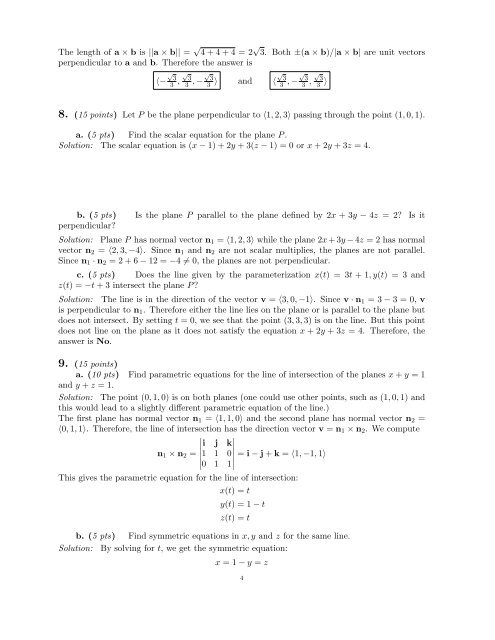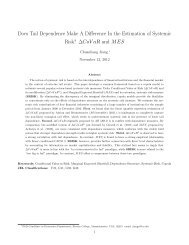MULTIVARIABLE CALCULUS PRACTICE MIDTERM 1 SOLUTIONS
MULTIVARIABLE CALCULUS PRACTICE MIDTERM 1 SOLUTIONS
MULTIVARIABLE CALCULUS PRACTICE MIDTERM 1 SOLUTIONS
You also want an ePaper? Increase the reach of your titles
YUMPU automatically turns print PDFs into web optimized ePapers that Google loves.
The length of a × b is ||a × b|| = √ 4 + 4 + 4 = 2 √ 3. Both ±(a × b)/|a × b| are unit vectors<br />
perpendicular to a and b. Therefore the answer is<br />
√ √ √ √ √ √<br />
〈− 3<br />
3 , 3<br />
3 , − 3<br />
3 〉 and 〈 3<br />
3 , − 3<br />
3 , 3<br />
3 〉<br />
8. (15 points) Let P be the plane perpendicular to 〈1, 2, 3〉 passing through the point (1, 0, 1).<br />
a. (5 pts) Find the scalar equation for the plane P .<br />
Solution: The scalar equation is (x − 1) + 2y + 3(z − 1) = 0 or x + 2y + 3z = 4.<br />
b. (5 pts) Is the plane P parallel to the plane defined by 2x + 3y − 4z = 2 Is it<br />
perpendicular<br />
Solution: Plane P has normal vector n 1 = 〈1, 2, 3〉 while the plane 2x + 3y − 4z = 2 has normal<br />
vector n 2 = 〈2, 3, −4〉. Since n 1 and n 2 are not scalar multiplies, the planes are not parallel.<br />
Since n 1 · n 2 = 2 + 6 − 12 = −4 ≠ 0, the planes are not perpendicular.<br />
c. (5 pts) Does the line given by the parameterization x(t) = 3t + 1, y(t) = 3 and<br />
z(t) = −t + 3 intersect the plane P <br />
Solution: The line is in the direction of the vector v = 〈3, 0, −1〉. Since v · n 1 = 3 − 3 = 0, v<br />
is perpendicular to n 1 . Therefore either the line lies on the plane or is parallel to the plane but<br />
does not intersect. By setting t = 0, we see that the point (3, 3, 3) is on the line. But this point<br />
does not line on the plane as it does not satisfy the equation x + 2y + 3z = 4. Therefore, the<br />
answer is No.<br />
9. (15 points)<br />
a. (10 pts) Find parametric equations for the line of intersection of the planes x + y = 1<br />
and y + z = 1.<br />
Solution: The point (0, 1, 0) is on both planes (one could use other points, such as (1, 0, 1) and<br />
this would lead to a slightly different parametric equation of the line.)<br />
The first plane has normal vector n 1 = 〈1, 1, 0〉 and the second plane has normal vector n 2 =<br />
〈0, 1, 1〉. Therefore, the line of intersection has the direction vector v = n 1 × n 2 . We compute<br />
i j k<br />
n 1 × n 2 =<br />
1 1 0<br />
= i − j + k = 〈1, −1, 1〉<br />
∣0 1 1∣ This gives the parametric equation for the line of intersection:<br />
x(t) = t<br />
y(t) = 1 − t<br />
z(t) = t<br />
b. (5 pts) Find symmetric equations in x, y and z for the same line.<br />
Solution: By solving for t, we get the symmetric equation:<br />
x = 1 − y = z<br />
4
















